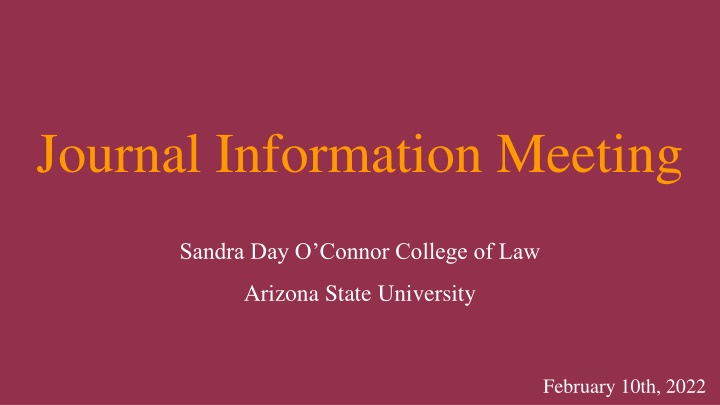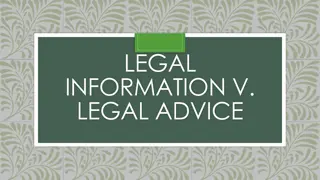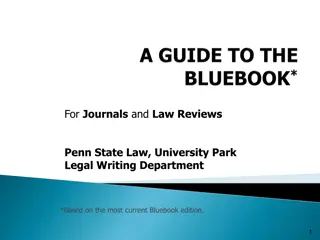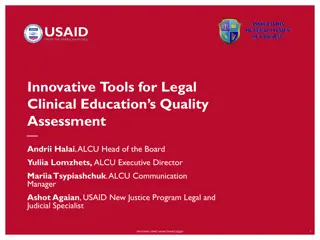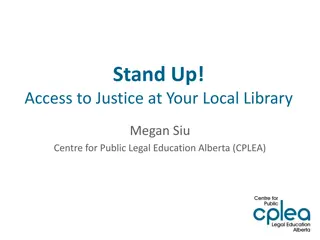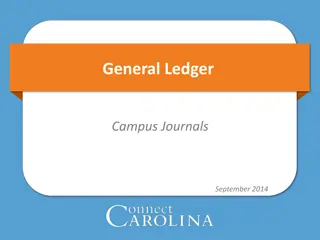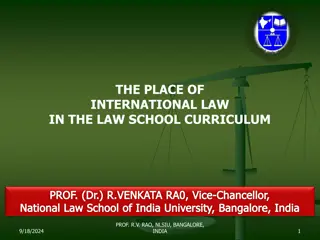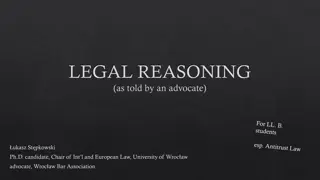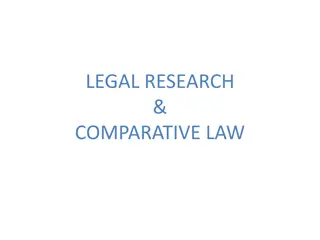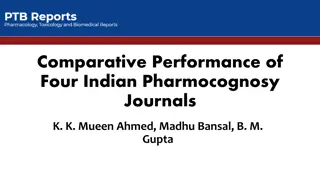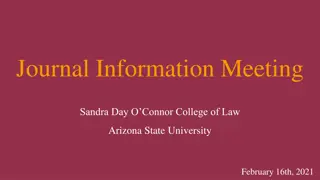Law Journals and Opportunities in Legal Education
Law journals play a crucial role in legal education by publishing scholarly articles and providing various opportunities for students to enhance their skills and advance their careers. Joining a law journal can open doors to employment, leadership roles, clerkship opportunities, networking, and skill development. Learn more about the significance of law journals and how to prepare for the Write-On Competition in this informative content.
Download Presentation

Please find below an Image/Link to download the presentation.
The content on the website is provided AS IS for your information and personal use only. It may not be sold, licensed, or shared on other websites without obtaining consent from the author.If you encounter any issues during the download, it is possible that the publisher has removed the file from their server.
You are allowed to download the files provided on this website for personal or commercial use, subject to the condition that they are used lawfully. All files are the property of their respective owners.
The content on the website is provided AS IS for your information and personal use only. It may not be sold, licensed, or shared on other websites without obtaining consent from the author.
E N D
Presentation Transcript
Journal Information Meeting Sandra Day O Connor College of Law Arizona State University February 10th, 2022
What is a law journal? Student-run organization that publishes scholarly articles from professors, legal scholars, and students across the country and world Journals might also organize various symposiums and other events that focus on specific topics Often cited by legal scholars, courts, and other legal entities Of course, getting cited improves the prestige of a law journal Sandra Day O Connor College of Law Arizona State Law Journal Corporate & Business Law Journal Jurimetrics: The Journal of Law, Science, and Technology Law Journal for Social Justice Sports and Entertainment Law Journal
Why join a law journal? Employment opportunities Many employers prefer to see a law journal membership on a resume Practicing attorneys often served on a law journal themselves during law school Employers know that being on a law journal provides one with a valuable set of skills Leadership opportunities Get involved and apply for leadership positions Clerkship opportunities Connect with clerks and judges Find a mentor who can provide tips about the process Create a strong writing sample Networking with attorneys and other legal or business professionals Master the Bluebook & become familiar with the Redbook Improve as a writer Connect with other students who are going to be your future colleagues & friends
How? The Write-On Competition 2022 Write-On Exam at-home exam after Spring final exams Start: Monday, May 9th at 8AM Finish: Tuesday, May 10th at 5PM 33 hours? Yes! Part I: Bluebook Citation Exam 50 multiple choice questions Bluebook offers a free online 3-day trial Part II: Closed-Universe Memorandum No research allowed, materials will be provided Grading & Application Process Exams are anonymously graded, using your ASU Law exam numbers Each journal uses specific criteria to determine whom to extend an invitation You can apply for multiple journals Selection process will be explained later
How to prepare in the meantime? No need to stress! If you want to get started now, you can do the following: Look through your Bluebook and tab rules as you go Remember: law journals use the Whitepages, not the Bluepages Lexis Interactive Citation Workstation (Practice questions) Review your first semester memorandums understand CREAC, IRAC, etc. Attend mandatory second meeting via Zoom on Thursday, March 31st at 12:15 PM Turn in mandatory Grade Release Form more information coming soon Always watch out for announcements using Daily Disclosure, Facebook, GroupMe, etc.
Arizona State Law Journal (ASLJ) Established in 1969, the Arizona State Law Journal is a nationally recognized legal periodical that serves as the primary publication of the Sandra Day O Connor College of Law at Arizona State University. Routinely cited in major textbooks, treatises, and opinions at all levels of the state and federal judiciary, including the United States Supreme Court High standards and excellent reputation for over 50 years Emphasis on citation and writing skills Highly regarded for post-graduate employment and clerkships Time Commitment: 6-8 hours per week (CCs, N&C, Blog, Committees) Editor-in-Chief: Sarah Brunswick
Arizona State Law Journal Grading Criteria 35 - 40 Staff Writers Only requirement is the Write-On Competition Grading Criteria: Bluebook Exam (25%) Memorandum (25%) GPA through Spring (45%) Legal Writing Grades (5%) Legal Method & Writing Grade (2.5%) Legal Advocacy Grade (2.5%)
Corporate & Business Law Journal (CABLJ) Publish articles and comments on a variety of influential and novel topics pertaining to corporate and business law, including: Corporate governance Securities regulation Capital market regulation Employment law Mergers and acquisitions As these practice areas have historically been heavily influenced by east coast institutions and practitioners, CABLJ offers a unique opportunity for students, scholars, and the Arizona community as a whole to engage in the exchange of ideas and information surrounding these topics. Time Commitment: Varies widely, front-loaded, 6-8 hours/week to start
CABLJ Grading Criteria Approximately 20 - 35 Associate Editors Application Requirements: Write-On: 1L Writing Grades and GPA through Spring 2021: 20% Statement of Interest: 15% 250 words Experience or interest in corporate and business law How your background and skills will contribute to CABLJ Why you want to join a law journal Resume: 25% Bluebook Exam: 25% Closed Memorandum: 15% Contact Raynee Cooper at rscoope2@asu.edu with any questions.
Jurimetrics: The Journal of Law, Science, and Technology Jurimetrics, published quarterly, is the journal of the ABA Section of Science & Technology Law and the Center of Law, Science & Innovation. Jurimetrics is the oldest journal of law and science in the United States, and it enjoys a circulation of more than 8,000 including ABA members. Is the No. 1 peer-reviewed law journal for science, technology, engineering, and math fields in the United States. Highly regarded for post-graduation employment and clerkships. We publish multiple student pieces each year. Associate Editors are not required to write their note/comment on a topic involving law, science, or technology. Editor-in-Chief: Sara Kizer (sykizer@asu.edu)
Jurimetrics Grading Criteria This information is subject to change by the next executive board, but here is an estimate of what can be expected: 30-36 Associate Editors, 4-8 hours of work a week. Grading: Closed Memo: 20% Bluebook Exam: 25% GPA through the Spring: 15% 1L Writing Grades: 10% Statement of Interest: 15% Resume: 15% Jurimetrics Information Session: March 17, 2022, during lunch in-person and Zoom, more information to come through Daily Disclosure
Law Journal for Social Justice (LJSJ) The Law Journal for Social Justice (LJSJ) at Arizona State University s Sandra Day O Connor College of Law provides an enduring and meaningful forum for legal discourse, scholarship, and professional development, with special focus on local, national, and international social justice issues. Through its work, LJSJ seeks to share diverse voices and perspectives to promote a deeper understanding of the complex social justice issues in our society. LJSJ is acutely aware that the privilege of membership in the legal profession comes with the responsibility to rectify injustices. We recognize our duty to educate the community on a local and national scale so that real change is implemented. LJSJ accomplishes these goals through: Annual or biannual publication of a volume of social justice notes and comments written by students, practitioners, and professors. Blogs written by Associate Editors and published on our website (each Associate Editor writes one blog per semester in addition to cite checks for publication articles). Yearly symposium on a timely social justice issue. Working toward creating a socially just journal by creating manageable workloads, providing transparency in communication and openness to feedback, and centering the needs of our members. LJSJ does NOT require a note or comment, but members may choose to write a note or comment for their GWR requirement. Time Commitment: 3-10 hours per week, frontloaded.
LJSJ Grading Criteria LJSJ will be accepting approximately 20 Associate Editors. For more information contact Kacie Fountain at kefounta@asu.edu. Grading: Written Memo 15% Bluebook Citation Exam: 20% GPA (cumulative from Fall 2021 - Spring 2022): 10% Resume (1-2 pages): 25% Statement of Interest (500-1000 words, prompted): 30%
Sports and Entertainment Law Journal (SELJ) Founded in 2010, the Sports & Entertainment Law Journal is dedicated to providing the academic community, the sports and entertainment industries, and the legal profession with scholarly analysis, research, and debate concerning the developing fields of sports and entertainment law. The Journal also seeks to strengthen the legal writing skills and expertise of its members. The Journal is supported by the Sandra Day O Connor College of Law and the Sports Law and Business Program at Arizona State University. SELJ publishes biannually in the spring and fall in both digital and print format. Each issue contains essays and articles, as well as notes or comments on the latest topics in sports and entertainment law authored by professors, practitioners, and students. In addition, Associate Editors contribute to the SELJ blog by writing short, fun, and timely pieces about sports and entertainment law-related topics. SELJ Associate Editor Participation Requirements: Write one Note/Comment, written over the course of the school year, assisted by a faculty advisor Write one blog post for the year, coordinated by the Technology Editor Regular cite-checks over the course of the school year Participation in mandatory meetings and SELJ events
SELJ Grading Criteria In addition to the Write-On Competition materials, applicants must provide: Resume Statement of Interest (not to exceed 2 pages) that expresses an interest or background in sports, entertainment, or both, and how this background will contribute to SELJ Grading Criteria: Resume: 15% GPA (through Spring): 15% Statement of Interest: 10% Closed Memo Response: 30% Bluebook Citation Exam: 30% For more information, please contact Allie Glover at allieglover@asu.edu.
Contact Information Arizona State Law Journal: sbrunswi@asu.edu Sarah - Jurimetrics: Sara - sykizer@asu.edu Sports & Entertainment Law Journal: Allie - allieglover@asu.edu Kacie - Law Journal for Social Justice: kefounta@asu.edu Corporate and Business Law Journal: Raynee - rscoope2@asu.edu Write-On Competition Questions: Joanna -
